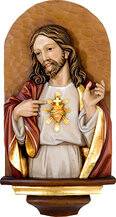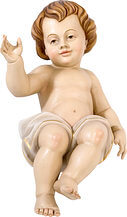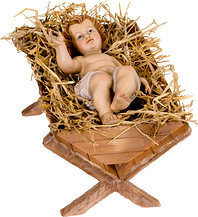All over the world, millions of people still gather on Christmas Eve, December 24, to celebrate the next birth of Jesus Christ. But was Jesus really born on that date? Here you will find the answers to all the questions about the birth of Jesus.
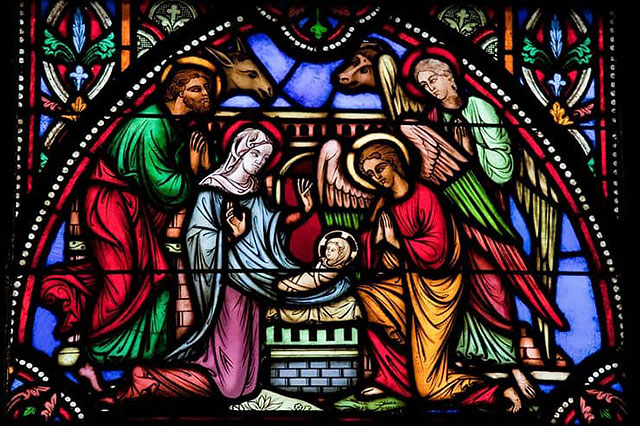
Table of contents
- When was Jesus born?
- What is known about the birth of Jesus according to the Bible?
- What is wrong with the date of Christmas?
- Why do we celebrate the birth of Jesus at Christmas?
- Did Jesus Christ really live? The most important information at a glance
- The childhood and youth of Jesus
- Jesus the preacher
- The Crucifixion
- The customs surrounding the birth of Jesus
When was Jesus born?
According to legend, Jesus Christ was born on the night between 24 and 25 December in the year 0. Christians all over the world therefore traditionally celebrate the birth of the Messiah and Son of God on this date as Christmas. But is this the true date of Jesus' birth?
In the New Testament there is no mention of Jesus' date of birth. Even the Encyclopaedia of Theology and the Church says: "The true birthday of Jesus is unknown". This is not surprising, because people at that time were completely unaware of the year and the day. To this day the true birthday of Jesus is still unclear. But historians meanwhile agree that Jesus was neither born on 25 December nor in the year 0.
Background: Jesus himself never wrote the story of his life. What we think we know about him is based on the four gospels of Matthew, Mark, Luke and John in the New Testament, each of which tells us the life of Jesus from its own perspective. Only Luke (1:26-2:52) and Matthew (1:18-2:23) tell stories of Jesus' childhood and birth. The well-known biblical Christmas story about the birth of the Son of God, which is based on these two scriptures, is still the basis of many Christmas customs: it is re-enacted in the nativity scene in church services and schools, read aloud at Christmas, and in many families traditionally re-enacted with the setting up of a Nativity sets.
What is known about the birth of Jesus according to the Bible?
 The Bible recounts the life of Jesus and his birth.
The Bible recounts the life of Jesus and his birth.So there is little valid information about the actual date of Jesus' birth. What emerges from the two biblical traditions of Luke and Matthew is:
- Jesus was born in Bethlehem, Judea.
- Herod the Great was king in Israel at the time of Jesus' birth. But he actually died already in 4 BC and not in the year 0, so the period from 7 to 4 BC can be considered as the time of Jesus' birth.
- Jesus' parents were called Mary and Joseph, who were engaged at the time of his birth.
- According to the Bible, the birth of Jesus was a virgin birth by the action of the Holy Spirit.
What is wrong with the date of Christmas?
According to the Bible, a birth date in December is unlikely, because there are various indications in the Bible that the date of 25 December cannot be correct.
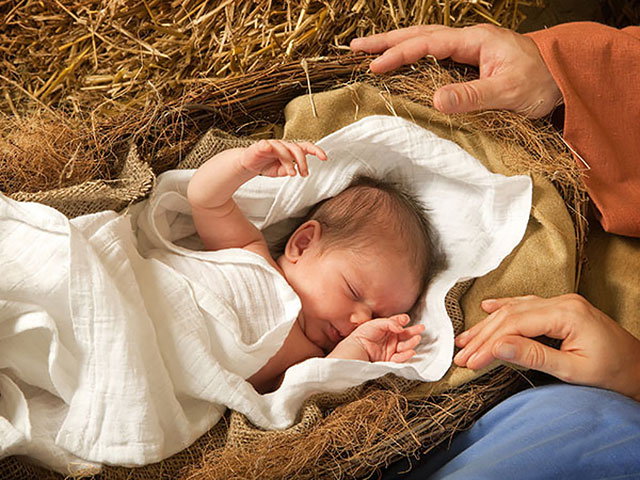 The Christmas story says that Jesus was born in a stable in Bethlehem and was laid in a manger.
The Christmas story says that Jesus was born in a stable in Bethlehem and was laid in a manger.The story of the birth of Jesus begins in Luke's Gospel with the Emperor Augustus asking for a census. For this reason, Joseph set off on the 150-kilometre journey from Nazareth to Bethlehem with the pregnant Mary. That this census took place in winter is unlikely in reality: would the emperor really have expected his people to make such a long and arduous journey in the middle of winter?
When Mary and Joseph arrive in Bethlehem, she gives birth to their son. The newborn baby, inside the Nativity sets is wrapped and placed in a manger with clean straw. Hence the assumption that Jesus was born in a stable. In the Gospel of Luke we read: "And there were shepherds in the same region, standing in the open field and keeping watch over their flock by night" (Lk 2:8). This also suggests a birth in a warmer season, because in the middle of winter there are no flocks of sheep in the fields around Bethlehem. At this time of year there is no grass in the fields and the animals are kept in a stable.
If 25 December was not Jesus' birthday, when was it? Researchers are always making new hypotheses and theses about this. But none of them is really valid and verifiable. When Jesus of Nazareth was really born will probably remain a secret forever.
Why do we celebrate the birth of Jesus at Christmas?
The Nativity sets under the Christmas tree is a symbol of the Christmas story: Mary and Joseph with the baby Jesus surrounded by shepherds, travellers and animals in the stable. A scene from around 2000 years ago, which is still the reason for celebrating Christmas today. But why do we celebrate the feast every year in December, if it is not really Jesus' birthday?
Scientists still disagree, but most of them assume that the feast was introduced in Rome on 25 December in the fourth century under the Emperor Constantine.
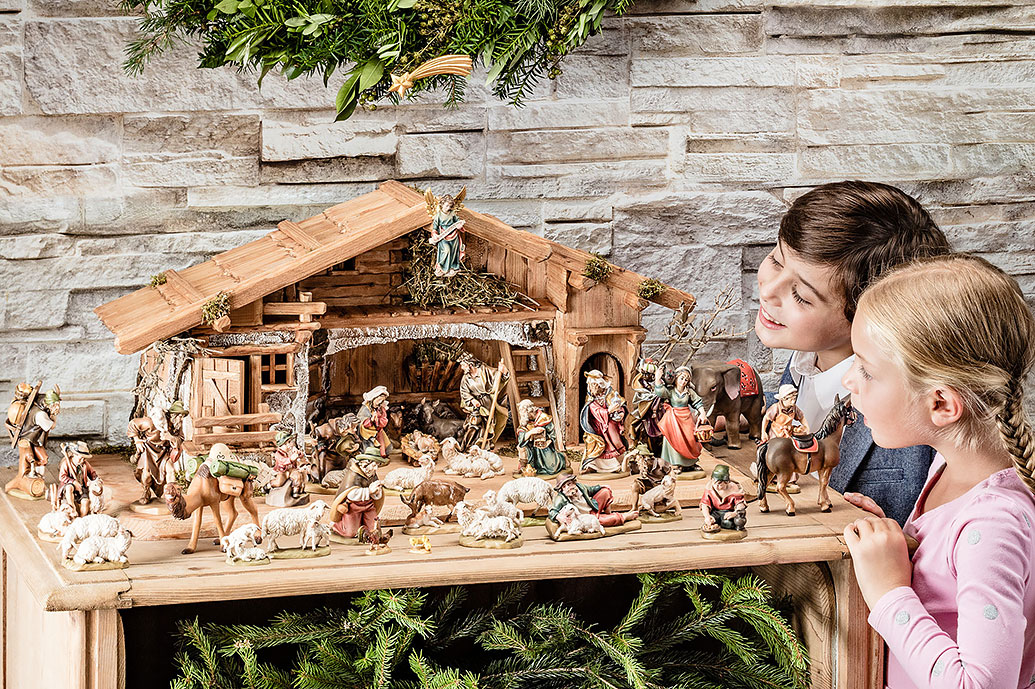 Figurative representations around the birth of Jesus in the form of Christmas cribs still inspire children and adults alike.
Figurative representations around the birth of Jesus in the form of Christmas cribs still inspire children and adults alike.A list of pagan holidays in the Roman calendar indicates that this date was very special among the pagans of that time. On this day the Romans celebrated the birthday of the Roman sun god Sol Invictus, the winter solstice and the 'rebirth of the sun'. They lit solstice fires and performed festivals in the circus. The Roman Saturnals also fell at this time in December: a Roman peasant festival in honour of the god Saturn. Researchers suspect that this date was therefore chosen as the feast of the birth of Christ. The custom probably spread to what is now Western Europe in the 7th and 8th centuries.
Did Jesus Christ really live? The most important information at a glance
There are many legends and myths surrounding the life and birth of Jesus. Only some of them are valid and only some have been clarified with certainty. What is clear to researchers is that a Jesus of Nazareth really lived. His birth was therefore a real event.
The childhood and youth of Jesus
Scientists today suspect that the Messiah was not born in a stable in Bethlehem, but in Nazareth. His parents and He were Jewish; little is known about His family and childhood. However, it can be assumed that Jesus had several younger brothers and sisters, because they appear in the Gospels, Acts and the letters of Paul. It is also obvious that Jesus first practised the profession of his father, who was a kind of craftsman. Moreover, Jesus could read and write, the evangelists tell us. This privilege was reserved for only a small part of the population at that time.
The greatest turning point in Jesus' life was his encounter with John the Baptist. Jesus was baptised by him, left his family to join the so-called 'desert preacher' and dedicated his life to religion. Eventually he separated from John and went on a pilgrimage alone to proclaim his message. As an itinerant preacher, he gathered an ever-growing group of followers around him.
Jesus the preacher
The four gospels detail the life of Jesus as a predicter, his religious message, how he healed the sick and performed miracles. He proclaimed that God's rule was at hand. He also addressed the poor, the sick and the marginalised. Through his powerful sermons he became more and more popular among the people, which did not please the Roman rulers.
The Crucifixion
Pontius Pilate, the Roman emperor's administrator, finally had Jesus arrested and sentenced to death by crucifixion. This probably happened in 30 or 31 AD. Legend has it that Jesus rose from the dead on the third day after his crucifixion (Easter). Another 39 days later (Ascension Day) the Bible says that God, his Father, took him back to heaven.
The customs surrounding the birth of Jesus
Although the chronological order of the four gospels is different and the traditions are only partly similar, they still represent the foundation of the Christian faith Many beautiful Christmas customs, such as nativity scenes and plays, date back to the biblical story of Christmas around the birth of Jesus even if the date is not the actual birthday.
Celebrating Christmas today is a family tradition popular even for many Germans who profess no faith. This includes rituals such as cosy get-togethers, baking biscuits, making the Christmas tree and giving presents to loved ones. From early Advent onwards, candles, fairy lights, Christmas markets and carols create a cosy Christmas atmosphere throughout the country.
More posts

Christmas Eve: Why do we celebrate it?
According to its original meaning, Christians gather on Christmas Eve to celebrate the birth of Jesus. Non-Christian people also celebrate this day as a family holiday with presents. Learn more about the history and meaning of the day as well as traditional Christmas Eve dishes in this article.

Father Christmas: Who is he really?
As Christmas season approaches, children big and small begin to wait patiently for Father Christmas to arrive. But where does the symbolic figure of Father Christmas come from? And what does he look like in other countries? We give you the answers to these and many other questions in this article.

Advent Calendar: History & Meaning
For most people, it is impossible to imagine the pre-Christmas season without it. But where does the tradition of opening a little door each day actually come from? How long have Advent calendars been around and how have they changed over time?

